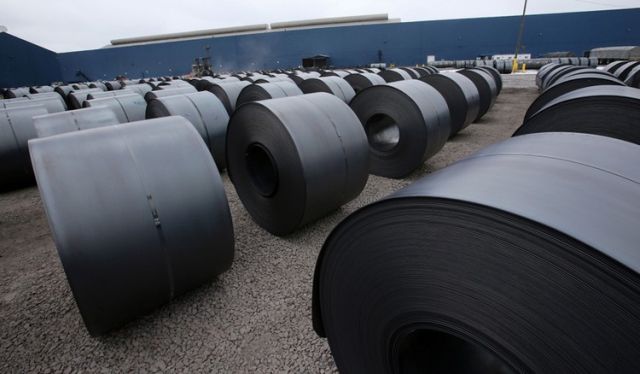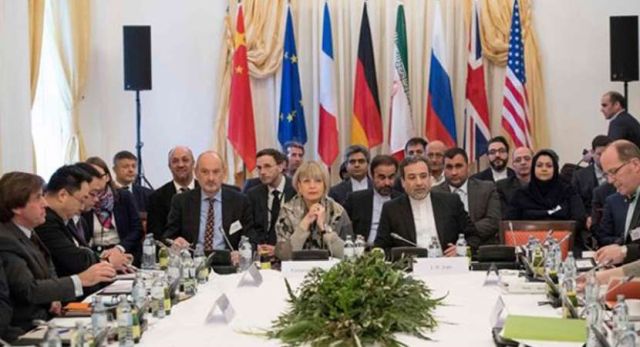
by admin | May 25, 2021 | Commodities, Commodities News, World
 Washington : The US Department of Commerce has started accepting the domestic industry’s product exclusion requests from the recently announced tariffs on steel and aluminum imports on Monday, according to a rule published by the department.
Washington : The US Department of Commerce has started accepting the domestic industry’s product exclusion requests from the recently announced tariffs on steel and aluminum imports on Monday, according to a rule published by the department.
The interim final rule, published on the government official journal Federal Register and formally effective on Monday, outlines the procedures for the US industry to seek such exclusions, reports Xinhua.
Approved exclusions will be made on a product basis by the Commerce Department and will be limited to individuals or organisations that submitted the specific exclusion request, according to the rule.
“These procedures will allow the Administration to further hone these tariffs to ensure they protect our national security while also minimising undue impact on downstream American industries,” US Secretary of Commerce Wilbur Ross was quoted as saying.
It is estimated that the department will receive steel tariff exclusion requests from 4,500 applicants and aluminum tariff exclusion requests from 1,500 respondents, according to Politico, a US political website.
However, the Office of the US Trade Representative has not informed the public how countries can be excluded from those tariffs, the report said.
The move came after the Trump administration’s announcement of a 25 per cent tariff on imported steel and a 10 per cent tariff on imported aluminum earlier this month, which would formally take effect on Friday.
—IANS

by admin | May 25, 2021 | Muslim World
 Washington : Saudi Arabia’s Crown Prince Mohammed bin Salman has said that women are “absolutely” equal to men as he is set to arrive in the US on Monday during which he will meet President Donald Trump and tour a number of American cities.
Washington : Saudi Arabia’s Crown Prince Mohammed bin Salman has said that women are “absolutely” equal to men as he is set to arrive in the US on Monday during which he will meet President Donald Trump and tour a number of American cities.
On Sunday, CBS News programme “60 Minutes” aired an episode about the prince and where he hopes to take Saudi Arabia.
When asked if women were equal to men, the Crown Prince said: “Absolutely. We are all human beings and there is no difference.”
He acknowledged that Saudi Arabia has been dominated by an “ultraconservative interpretation of Islam” that was wary of non-Muslims, deprived women of basic rights and constricted social life, the New York Times reported.
“We were victims, especially my generation that suffered from this a great deal,” he said about conservatism that spread through the kingdom after 1979.
Bin Salman’s rise to power has been accompanied by an easing of restrictions on women’s dress and an expansion of their role in the work force. He said the government was working on policies to ensure equal pay.
The kingdom had also allowed women to drive in an order which will go into force from June.
However, women in Saudi Arabia are still bound by so-called guardianship laws that give male relatives control over aspects of their lives.
Talking about his drive against corruption, he defended the recent jailing of over 380 princes, businessmen and former government ministers in the Ritz-Carlton in Riyadh as “extremely necessary.”
There were accusations of abuse by relatives and associates of the detained. They said that many detainees were subjected to “coercive tactics” and “physical abuse” to get them to sign assets over to the state.
The Saudi government, however, denied that any abuse took place.
The Crown Prince, who has been criticized for lavish personal expenses at a time when he is preaching fiscal responsibility, defended his private spending as “his business”.
In recent years, he bought a yacht for a half-billion dollars, a French chateau for over $300 million and a painting for $450 million, the New York Times reported.
“As far as my private expenses are concerned, I’m a rich person and not a poor person,” he said. “I’m not Gandhi or Mandela.”
—IANS

by admin | May 25, 2021 | Muslim World
 Tehran : Iran and the US may hold talks on 2015 Iranian nuclear agreement, or the Joint Comprehensive Plan of Action (JCPOA), in the Austrian capital of Vienna, the media reported.
Tehran : Iran and the US may hold talks on 2015 Iranian nuclear agreement, or the Joint Comprehensive Plan of Action (JCPOA), in the Austrian capital of Vienna, the media reported.
Citing Tehran Times daily, Xinhua reported the Iranian diplomatic team visiting Vienna for regular talks on the implementation of Iran’s nuclear deal would meet other participating sides including the US officials on Friday, a source close to the Iranian negotiators said on condition of anonymity.
The two sides would talk about the removal of sanctions on Iran as well as the examples of violations of the deal by Washington.
Representatives of Iran and other parties, including the US, Britain, Germany, France, China and Russia, launched the latest round of the JCPOA Joint Commission in Vienna on Friday.
Under the JCPOA, Iran must limit its nuclear program in exchange for the lifting of international sanctions.
On January 12, US President Donald Trump waived nuclear sanctions against Iran, but warned that he would not do it again unless the deal is fixed.
Tehran, however, has repeatedly said it will not renegotiate the nuclear deal.
—IANS

by admin | May 25, 2021 | Corporate, Corporate Governance, Corporate Reports, News, Politics
 By Arul Louis,
By Arul Louis,
United Nations : As New Delhi diversifies its arms purchases, the US is rapidly increasing its arms sales to India, emerging over the last five years as its second biggest supplier by providing 15 per cent of its weapons imports, a study by Sipri said.
Washington increased its sales by more than five times compared to the previous five years, the authoritative Stockholm International Peace Research Institute said in its report released this week.
Israel has moved up to the third spot accounting for 11 per cent of India’s imports during the 2013-17 calendar years, Sipri added.
Although Russia remained by far India’s biggest arms seller, it share of total imports has fallen.
Russia had a 62 per cent share of India’s arms imports during the past five years, down from 79 per cent in 2008-12, according to the report that tracks the global arms trade.
Overall, India is the world’s biggest importer of major arms accounting for 12 per cent of the total global imports during the last five years and it increased purchases abroad by 24 per cent compared to the previous five-year period, Sipri said.
“The tensions between India, on the one side, and Pakistan and China, on the other, are fuelling India’s growing demand for major weapons, which it remains unable to produce itself, Sipri Senior Researcher Siemon Wezeman wrote.
“China, by contrast, is becoming increasingly capable of producing its own weapons and continues to strengthen its relations with Pakistan, Bangladesh and Myanmar through arms supplies,” he wrote.
In contrast to India, Pakistan’s arms imports declined significantly during the last five years, when imports from the US dropped dramatically compared to the previous five years while supplies from China increased.
“Despite its continuing tensions with India and ongoing internal conflicts, Pakistan’s arms imports decreased by 36 per cent between 2008-12 and 2013-17,” the report said.
“Pakistan accounted for 2.8 per cent of global arms imports in 2013-17.”
Pakistan’s arms imports from the US dropped by 76 per cent in the latest five-year period compared with the previous one, the study said.
China was Pakistan’s main source of arms in 2013-17, and there was a large increase in Chinese arms exports to Bangladesh in that period, Sipri said.
According to supplementary arms import data for India provided to IANS by Sipri, the share of India’s imports from the US increased from 2.7 per cent of its total during 2008-12 to 15 per cent in the latest five-year period as it overtook Uzbekistan, Britain and Israel.
Uzbekistan, which was India’s second biggest import source accounting for 4.3 of its purchases abroad during 2008-12 did not sell any after 2011, according to the data.
Weapons imports from Britain fell to 3.2 per cent of the total during the last five years, while it was 5.2 per cent in 2008-12, a drop of 23 per cent during that period that moved it down from the third spot to the fifth.
France has moved up to the fourth spot accounting for 4.6 per cent of India’s imports during the last five years, an increase of 572 per cent compared to just 0.8 per cent.
Sipri does not assign monetary values for the arms trade and uses its own system called Trend-Indicator Value (TVI) because “data available from public sources will give sometimes monetary values, but also often such values are not available, not detailed, not clear or not comparable (between countries who report on different ‘weapons’ or as the coverage changes over time) enough to be useful,” Wezeman explained to IANS.
Under this way calculating, India’s total TVI rose from 14,608 during 2008-12 to 18,048 for 2013-17.
According to this valuation system, India’s arms purchases have come down during the last full three years of Bharatiya Janata Party government compared to the last three full years of the Congress-led United Progressive Alliance rule.
During 2011-13, India’s imports were valued at 13,319 TVI by Sipri, but only 9,499 TVI in 2015-17. When both parties held power at different times during 2014, the imports were 3,227 TVI.
(Arul Louis can be reached at arul.l@ians.in)
—IANS

by admin | May 25, 2021 | World
 Moscow : Despite the anti-Russia propaganda, US tourists to Russia increased by 25 per cent in the first nine months of 2017, the chief of Russia’s Tourism Agency said on Thursday.
Moscow : Despite the anti-Russia propaganda, US tourists to Russia increased by 25 per cent in the first nine months of 2017, the chief of Russia’s Tourism Agency said on Thursday.
Russia’s border authorities recorded the increase compared with the same period of 2016, Oleg Safonov, head of Russian Federal Agency for Tourism, told the Izvestia daily in an interview.
“The anti-Russia propaganda only arouses great interest among American citizens for our country,” Xinhua quoted Safonov as saying.
Safonov also explained why the anti-Russia propaganda helps. “American citizens are told various stories about what is going on in Russia, no wonder they want to come and see everything for themselves.”
Safonov said American tourists are not disappointed by what they see in Russia. They see a “modern, peaceful and developed country”, he added.
—IANS

 Washington : The US Department of Commerce has started accepting the domestic industry’s product exclusion requests from the recently announced tariffs on steel and aluminum imports on Monday, according to a rule published by the department.
Washington : The US Department of Commerce has started accepting the domestic industry’s product exclusion requests from the recently announced tariffs on steel and aluminum imports on Monday, according to a rule published by the department.



